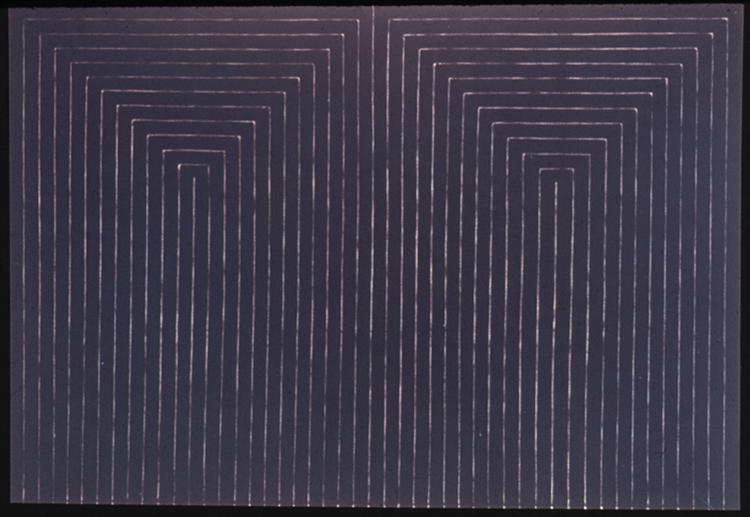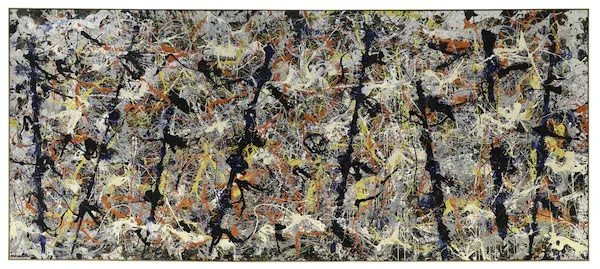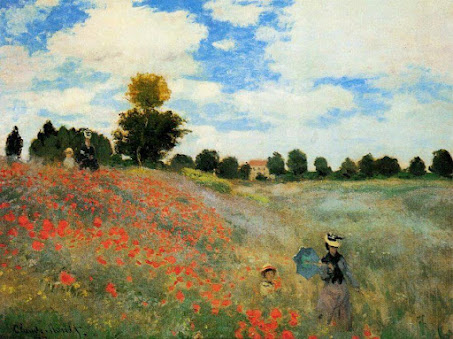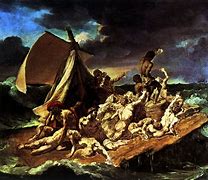Mid-Modernism
Marriage of Reason and Squalor II
Frank Stella (1953)
The mid-modern age was one of constant change, which is shown in the many styles of the time. One of the styles to come out of this period is Minimalism, a form focusing on straightforward visuals where the art simply represents exactly what it is physically. Shown above is the Marriage of Reason and Squalor II by Frank Stella. It is one of the most famous Minimalist works, purposefully shying away from using line to create any kind of three-dimensional form and instead retreating into what it is, a matched set of lines on black. Stella was one of the mos influential Minimalist artists at the time and is known for describing the style with, "What you see is what you see" (moma.org).The Musket
Frank Stella (1990)
Another work from Stella is shown above. The Musket is a sculpture meant to demonstrate Stella's dissatisfaction and confusion towards the mid-modern art world. In a time dominated by Cubism and other forms of abstraction, Stella felt cornered and misunderstood by his contemporaries, as if the mangled mess of a musket were pointed towards himself. The way he uses form in this sculpture is very interesting, and seemingly meant to represent the abstraction he so avoided in his works. Both of these works from Stella represent the fears of an artist in an ever-changing and growing art world and demonstrate a desire to break away from the norm.
Autumn Rhythm
Jackson Pollock (1950)
One of the most famous artists from the Mid-Modern era is Jackson Pollock. His works were famous for their absence of subject matter, unorthodox technique, and abstraction. Shown above is Autumn Rhythm, a painting he created using a bevy of unorthodox tools to spread the paint. With Pollock's work the meaning came from the act of painting itself. The movements he makes, the headspace he was in is what encapsulates his meaning. this results in a deliberate, emotional, powerful piece that displays all of what Pollock wishes to share. The painting itself rejects artistic elements such as form to be less restricted in the emotions it portrays.
Blue Poles
Jackson Pollock (1959)
Blue Poles by Pollock goes further with its expressionism, representing deeply personal and private thoughts of the artist. The harsh blue lines combined with the hectic colors illustrate the unhealthy mental state of Pollock at the time. During this point in his life he suffered from alcoholism and depression and used his paintings as a way to convey his most complicated emotions, the worst of which are on full display in Blue Poles. Many other artists in the Mid-Modern era practiced abstract expressionism, finding an ever-changing and modernizing world after the war to be increasingly difficult to convey their frustrations and fears.
Relativity
M.C. Escher (1953)
Another style to emerge in this era is known as Op art or optical art. This genre focuses on using lines and space to distort the human perception and confuse the eye. Mc Escher is one of the most well-known artists of the genre and his work, Relativity is displayed above. The piece shows humanoid figures going about their lives independently, each disregarding the laws of gravity in relation to the last. This painting demonstrates the thoughts of Escher on the human condition, with each group acting on their own and failing to recognize the world through the lens of others, while also being blank slates, with little to do besides their assigned tasks. The use of space in this picture is confusing and backwards, confusing the viewer to further the artist's point that we are confused when confronted by a flipped worldview.
Sky and Water I
M.C. Escher 1938
Another noteworthy Escher piece is Sky and Water, shown above. It is by and large simpler than Relativity, only depicting a visual illusion wherein flying ducks and swimming fish fit together. The tone in this piece is used to trick the viewer into questioning what is a duck and what is a fish. Works like the two presented here show more contemporary change through Op art, with these artists wishing to challenge their viewers physically and mentally with their art.
Bibliography
“MoMA | Frank Stella. The Marriage of Reason and Squalor, II. 1959.” Moma.org, 2020, www.moma.org/learn/moma_learning/frank-stella-the-marriage-of-reason-and-squalor-ii-1959/.
Messham-Muir, Kit. “Here’s Looking At: Blue Poles by Jackson Pollock.” The Conversation, 10 Jan. 2019, theconversation.com/heres-looking-at-blue-poles-by-jackson-pollock-51655.
“Frank Stella - the Musket.” Heather James, www.heatherjames.com/art-detail/frank-stella-38576-the-musket/.









Hello Christopher, I enjoyed reading your post about mid-modernism styles. My favorite style of this era is abstract art, as it encourages artist to not have follow a specific form. It can be anything from vigorous brushstrokes and splatters to undesignated smooth lines. Your section on optical art was fascinating, I really liked the paintings you chose to analyze for this section. The piece titled Sky and Water was interesting to look at, while it is a simpler design, it was still one that messed with my vision and was a joy to admire. I also love anything to do with ducks and fish, which is another reason I appreciated this painting. Great post!
ReplyDelete